|
by Michael A. Morrow |
|
|
|
|
|
CT-4 Airtrainer  
|
Aerospace of New Zealand's cute little tricycle-geared primary trainer as used by the Royal Australian Air Force. With smaller of two props shown on plan, it'll ROG. Two color schemes - the yellow and black RAAF color scheme as shown on the plan, and the red and white RNZAF color scheme shown in the color photograph of the model built by Bob Jamison. Click on picture for photo. |
to order, see the How to Order section. |
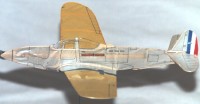
|
Sleek experimental navy carrier fighter based on the P-39 Airacobra. Pre-war color scheme - yellow wings and silver fuselage. Like the P-39 airacobras, a good flier. Click on picture for photo. |
to order, see the How to Order section. |
  |
The Blackburn Skua. Obsolete before the war even started, this two-seat fighter and dive-bomber achieved several notable firsts, including the first fleet Air Arm aircraft to produce an ACE, and sinking the German cruiser Konigsberg. Click on picture for enlarged version. |
to order, see the How to Order section. |

|
Blohm & Voss's entry in the "Volksjager" competition was the better design, but Heinkel's He-162 got the contract. The BV P 211.02 may have lost out to the He-162, but as a No-Cal, it won't lose to much else! An EXCELLENT flier! Click on picture for photo. |
to order, see the How to Order section. |
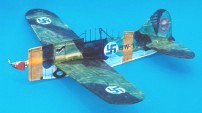 In the colorful markings of a B-239 with 41 victories - more than the highest scoring Allied Ace of WW II! Green & black camo, yellow cowl & fuselage stripe, red spinner & tail number. |
The B-239 was lighter, climbed faster, and was more maneuverable than later models of the Buffalo, and it had the highest victory ratio of any WW II fighter - 26:1 !!! The Finnish Air Force had only 44 B-239s, but they made 34 Aces! Both a standard, or a lightweight version with lifting stab can be built from this plan. My lightweight version has done 3 minutes under a 26' ceiling, and has already won multiple events. Click on picture for photo. |
to order, see the How to Order section. |
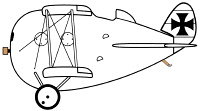
|
This 1915 WWI experimental fighter was an effort to make a small fast fighter. Unfortunately, the aircraft crashed on the test flight, which ended the experiment, but you can fly this terminally cute little WWI fighter as a No-Cal with much greater success. The color scheme is simplicity itself, with black details on an overall white aircraft. |
to order, see the How to Order section. |

|
Pierre Clostermann, a leading allied ace, and three of his squadron mates tried chasing a Do-335 with their Tempests, which were VERY fast aircraft, and gave up because ". . . he was easily gaining on us." A long nose, lots of wing area, and a long motor tube give the Do-335 great proportions. A great flier! Decorating tips for the Dornier Do-335 can be found here. |
to order, see the How to Order section. |
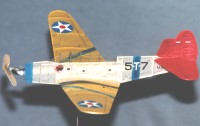 Click on picture for photo. |
One of the most colorful No-Cals you're likely to see. Pre-war yellow wing and light grey fuselage. Tail color depends on carrier assignment, and nose/fuselage/wing stripes depend on aircraft number. Several color schemes available. To pick your own color scheme, use in conjunction with James A. Morrow's excellent TBD-1 Devastator scale drawing sheets 1, 2, and 3 in the scale drawing section. A nice little flier! |
to order, see the How to Order section. |
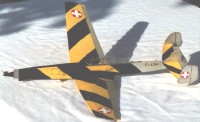
|
Swiss target tow plane with very long nose. Replacing the piston engine with a turbine in a WW II vintage fighter-bomber required stretching the nose to maintain the proper center of gravity. Nose is almost too long for a No-Cal! Striking yellow and black striped color scheme. Click on picture for photo. |
to order, see the How to Order section. |
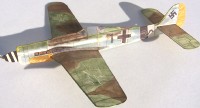
|
The Best German production fighter of WW II! This lightweight version of the "Dora 9" is capable of excellent performance. Build with lifting or non-lifting stab., low & high-ceiling props. 3 minutes with 26' ceiling, & nearly 5 minutes with 80' ceiling! My new favorite! I've already won 5 events with this one! Click picture for larger photo. |
to order, see the How to Order section. |

|
This outstanding WW-I fighter makes a very colorful No-Cal, and a very nice flier. Click picture for larger photo. |
to order, see the How to Order section. |
 
|
At 7:45 in the evening on May 15, 1941, the Gloster Whittle became Great Britain's first jet aircraft to fly. A long nose gives this little No-Cal nice moments and a long motor tube. A good little flier. The plan shows both the all-silver roll-out and early camoflage color schemes. Click on pictures for larger photos. Decorating tips for the Gloster Whittle can be found here. |
to order, see the How to Order section. |
 Click on picture for photo. |
The Grumman FM-2 Wildcat was lighter and climbed faster than earlier Wildcat versions, making it invaluable operating off escort carriers protecting allied convoys from enemy submarines. The plan shows an FM-2 in grey and white north Atlantic markings. Decorating tips for the FM-2 Wildcat can be found here. |
to order, see the How to Order section. |

|
Our very first No-Cal. A pretty model with a slight gull wing. Heinkel's "mystery fighter" was faster and more maneuverable than the Bf-109, but only a few were built. Spanish civil war color scheme - light grey with black and white trim. Click on picture for photo. |
to order, see the How to Order section. |
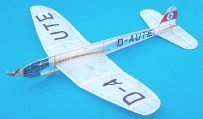
|
Dubbed the German "Mosquito", this contra-prop, tandem-engine bomber was faster than any single-engined fighter of it's day. Model is a natural performer - has done 3 minutes under a 26 foot ceiling! Aircraft is light gray overall with black registration and the typical pre-war tail marking of a black Hakenkreuz on white circle in a red band. Click on picture for photos! |
to order, see the How to Order section. |


|
Recent information reveals that this sleek little jet fighter actually made it into combat for a short period! It's combat career wasn't notable, but as a No-Cal, its long fuselage packs an 18 inch long motor tube! A Great flier! The closest thing to an outdoor No-Cal in the catalog, and winner of the 1997 mass launch at the Northwest Quiet Riot meet! Green and light blue color scheme. Click on picture for photo. |
to order, see the How to Order section. |
|
Rocket Interceptor  Click on picture for photo. 12 minutes 58 seconds ! July 18, 2004 (outdoors) |
Several of these little rocket interceptors were actually tested, but it never flew in combat. So... did somebody show up with a high-flying rece. Spitfire? Or maybe one of those big-winged Cassutts is floating around at altitude. Maybe you're tired of seeing those ten-minute outdoor No-Cal times in the FAC Newsletter. Get to altitude
FAST
with this No-Cal version of the Heinkel He-P.1077 Julia I Rocket-Interceptor. Huge model with lots of wing area and a 21 inch long motor tube! Put a big prop on it, make sure your name is on it, and watch it GO! Green and light blue color scheme. |
to order, see the How to Order section. |

|
This is gonna be a COOL No-Cal! Lots of motor tube. NOT a lot of fuselage. Natural metal color scheme. Click on picture for enlarged version! |
to order, see the How to Order section. |
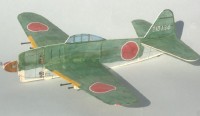 Click on picture for photo.
Click on picture for photo.
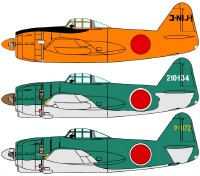 |
Probably the finest Japanese Naval fighter of the war, the N1K1-J Shiden (allied code name 'George') was more than a match for the Hellcat. The plan shows both the un-armed, all-orange prototype and a camoflaged N1K1-Ja production version (with under-wing canon pods) of this famous mid-wing fighter. The instruction sheet shows how to build a second production version, the N1K1-Jb (no under-wing canon pods - all canon in wings). Larger color profiles of all three versions can be found here. Decorating tips for the N1K1-J Shiden can be found here. |
to order, see the How to Order section. |
|
Flight Test Aircraft  
|
This is the Koolhoven FK-55 flight-test version (not the 1936 Paris Air Salon prototype). This aircraft was intended to have retractable gear, but for test flying, it had fixed gear. The FK-55 flight-test aircraft flew once before the aircraft was shelved. Click on picture for enlarged version! |
to order, see the How to Order section. |
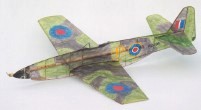
|
This sleek British fighter may have been one of the greatest prop fighters that ever flew, but it was tested only two months before Whittle's little jet fighter became operational, so it was never placed in production. As a No-Cal, its large wing and long fuselage make it a great flier! Dark Green and Dark Sea Grey color scheme. Click on picture for photo. |
to order, see the How to Order section. |

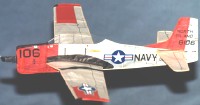
|
Navy primary trainer. A good flier. White and international orange color scheme. Click on picture for photo. |
to order, see the How to Order section. |

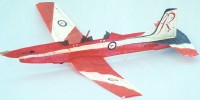
|
In use by air forces around the world. The long-nosed PC-9 makes a striking No-Cal model in the red, white, and blue livery of the "Roulettes", the Royal Australian Air Force Aerobatic team. Click on picture for photo. |
to order, see the How to Order section. |


|
A very fast (490 m.p.h.!) experimental version of the famous P-47 fighter aircraft fitted with an experimental water-cooled Chrysler engine. A Great flier! Olive drab and grey color scheme. Click on picture for photo. |
to order, see the How to Order section. |
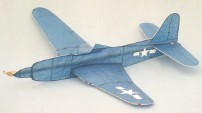
|
The "Darkshark" - a jet/turboprop experimental aircraft. The Darkshark has a long spinner, which is perfect for a No-Cal! Typical Naval color scheme - Overall Dark Navy blue with white stars. Click on picture for photo. |
to order, see the How to Order section. |

|
A model of the Short Seamew prototype for a British Fleet Air Arm anti-submarine spotter. This peculiar-looking aircraft makes a small, light No-Cal, and a good flier. All silver color scheme. Click on picture for photo. |
to order, see the How to Order section. |
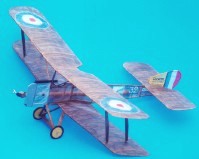
|
A cute little No-Cal version of the SOPWITH company's wonderful Sopwith 1 1/2 Strutter single seat bomber. A lifting stabilizer helps it along to 2 minute flights under a 26 foot ceiling without getting tangled in the rafters. Click picture for larger photo. |
to order, see the How to Order section. |
  |
Famous for rescuing Eddie Rickenbacker, the Vought OS2U Kingfisher was a fleet workhorse, performing observation, spotting, anti-submarine patrol, and rescue work. This No-Cal version has a big wing for good flights. Click picture for larger photo. |
to order, see the How to Order section. |

|
Two scale diameter props turning opposite directions make this unusual model a show-stopper. Difficult to flight trim, but looks GREAT in flight. Can you beat my flight of 13 seconds? Plan covers three 11" x 17" sheets. NOT for beginners! Click picture for photo. |
to order, see the How to Order section. |
  Click on profiles for larger pictures. |
One of the coolest fighters of the second world war. Nicknamed "Crikey", after a Shell Oil advertisement for it's high speed at ground level, this heavily-armed twin engine fighter fired the imaginations of many a school boy, and wreaked havoc on low-level rhubarbs, it's four 20mm canon and underwing bombs allowing it to take out trains, planes, trucks, and shipping with equal ability.
One rubber motor driving two props via a small gearbox makes it a stirring performer. NOT an easy build due to the gearbox, but definitely an awesome flier! |
to order, see the How to Order section. |


|
Post WW II British Fleet Air Arm fighter. The counter-rotating props have a looooong spinner, which is perfect for a No-Cal! The resulting long nose makes this a GREAT flier. Typical British colors - Dark Sea grey above, Sea Green (pale yellow with a green tint) below. Click on picture for photo. |
to order, see the How to Order section. |
|
(Beautiful Cloud) 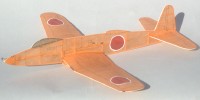 Click on picture for larger photo.
Click on picture for larger photo.
|
Designed as a long-range high-speed land-based reconnaissance aircraft, the R2Y1 was powered by two engines mounted in tandem in the fuselage driving a single prop in the nose. Circumstances eliminated the need for the aircraft, so the piston-engine R2Y1 was used as an aerodynamic prototype for the R2Y2 twin engine jet bomber. The R2Y1 flew on May 8, 1945. A long nose gives this No-Cal a long motor tube, and it's slender fuselage keeps the weight down. A very nice flier! Decorating tips for the R2Y1 Keiun can be found here. |
to order, see the How to Order section. |
|
|
|
|
AERO ACES is a TRADEMARK of Michael A. Morrow. © All Images, drawings, plans, articles, and kits, are Registered & Copyrighted by Michael A. Morrow |